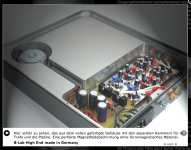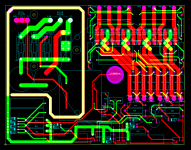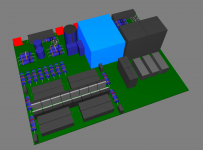@Joachim.....Thanks for information. Whatever some say on the blowtorch thread, JC is still a force to be reckoned with in real world commercial audio! He does take such unjust criticism very well, but he knows how good his realized designs are. (I heard a very large multi-amped JC/Levison based system in Italy.....it was very very good.) Also due to health problems last year I have done little DIY, but, touch wood, I am much improved and only have a hernia operation in mid-Jan to go before I have absolutely no excuses.
I find that following your threads here on DIYAudio has given me a renewed interest and, now, determination to get going again! Bit like a drug..........Thanks for being a brilliant "pusher"
I find that following your threads here on DIYAudio has given me a renewed interest and, now, determination to get going again! Bit like a drug..........Thanks for being a brilliant "pusher"
Sending a PM....

Many many thanks for this info........it is very kind of you.
Gave a great remainder of Christmas and a very successful New Year.
Thanks Brian. I am particular impressed what John did early on, back in the 70th where i was still sleeping. The circuits may look simple but they are also sophisticated and elegant, a combination hard to do when you ask me. He also alerted me that PSU and parts choices are critical. So did Be`, Morecroft, Hiraga, Pass and Hawksford to name but a few. Modern High End got very complex and not always for the better in terms of sound and feeling. So tuning an old goody is fun.
Now that the hum is gone i have a chance to fine tune.
Gain in the original version in my setup is a bit high. I really had trouble to dial in volume and balance.
So i reduced the gain by reducing the load resistor.
I have now loaded with 100 Ohm instead of 160 Ohm.
The sound improved. It is kind of sweeter and the bass came back so i had to reset the subs to the value i mostly used. Strange but true.
The transparency is still there but the " tone " is fuller and more natural. Very nice, i am happy.
Now that the hum is gone i have a chance to fine tune.
Gain in the original version in my setup is a bit high. I really had trouble to dial in volume and balance.
So i reduced the gain by reducing the load resistor.
I have now loaded with 100 Ohm instead of 160 Ohm.
The sound improved. It is kind of sweeter and the bass came back so i had to reset the subs to the value i mostly used. Strange but true.
The transparency is still there but the " tone " is fuller and more natural. Very nice, i am happy.
i found this helpful :
http://www.camsemi.com/pdfs-technical/CamSemi_AN-2576_HV_BJT_production_inspection.pdf
http://www.camsemi.com/pdfs-technical/CamSemi_AN-2576_HV_BJT_production_inspection.pdf
I buy them here :
BC 140-16 - Transistor NPN TO-39 40V 1A 0,8W bei reichelt elektronik
They are made by Continental India. They are dead quiet and sound wounderfull.
I am particular impressed with the Early Voltage of the PNP. Up to 6mA idle it is just a straight line.
BC 140-16 - Transistor NPN TO-39 40V 1A 0,8W bei reichelt elektronik
They are made by Continental India. They are dead quiet and sound wounderfull.
I am particular impressed with the Early Voltage of the PNP. Up to 6mA idle it is just a straight line.
They are from the stone age. Maybe Contineltal has improved the process and does noise screaning, who knows. There was a noise tester in the 70th, very expensive, i forgot the name. Maybe they bought the whole schebang from Germany.
In the 70th my Physicist friend selected them for noise, do not ask me how, and his early 80th phono was dead quet. Also Stan Curtis used selected PNPs in an MC phono with a long tail pair input stage and that was quiet too although it has a 6dB noise disadvantage compared to parallel symmetric. I did not even noise screan the ones i used. So far there was never a bad one. I also can not detect any popcorn and flicker noise.
1/F frequency is low too my measurements show. OK, Hfe is around 200 and i wish that would be higher. In the old days there was a high Hfe version too, the -25, but i can not find them any more on the market.
In the 70th my Physicist friend selected them for noise, do not ask me how, and his early 80th phono was dead quet. Also Stan Curtis used selected PNPs in an MC phono with a long tail pair input stage and that was quiet too although it has a 6dB noise disadvantage compared to parallel symmetric. I did not even noise screan the ones i used. So far there was never a bad one. I also can not detect any popcorn and flicker noise.
1/F frequency is low too my measurements show. OK, Hfe is around 200 and i wish that would be higher. In the old days there was a high Hfe version too, the -25, but i can not find them any more on the market.
Last edited:
I remember now, it was Quantech.
I wish i had one. It also measures Rbb`.
I can do that with a substitution method but i rather put the transistor in question into a circuit i know and listen.
Noise is just one parameter important for sound. There is also Hfe linearlty and high Early Voltage, affecting second and third harmonic. Cob is important for speed.
Also in a parrallel symmetric design with BJTs it is important that the logarithmic law matches from NPN to PNP.
The modified Curl is ideal to study this because it only used current feedback and no negative feedback in high measure that whould erode the differences.
It could be argued that NFB performs better. Technically that is correct but i have more fun to optimize my circuits as much as i can without that drastic correction measure. Also some say that no NFB circuits sound better. That is hard to prove with only subjective evidence. I can only say that i know good sound and a suffient number of the peple that use my stuff agrees.
http://www.mcmlv.org/Archive/TestEquipment/QuanTech2173-C.pdf
I wish i had one. It also measures Rbb`.
I can do that with a substitution method but i rather put the transistor in question into a circuit i know and listen.
Noise is just one parameter important for sound. There is also Hfe linearlty and high Early Voltage, affecting second and third harmonic. Cob is important for speed.
Also in a parrallel symmetric design with BJTs it is important that the logarithmic law matches from NPN to PNP.
The modified Curl is ideal to study this because it only used current feedback and no negative feedback in high measure that whould erode the differences.
It could be argued that NFB performs better. Technically that is correct but i have more fun to optimize my circuits as much as i can without that drastic correction measure. Also some say that no NFB circuits sound better. That is hard to prove with only subjective evidence. I can only say that i know good sound and a suffient number of the peple that use my stuff agrees.
http://www.mcmlv.org/Archive/TestEquipment/QuanTech2173-C.pdf
Last edited:
Joachim the BC140/160 seems interesting transistors, are they obsolete?
Are they easy to source?
Farnell has a Multicomp version:
BC160-16 - MULTICOMP - TRANSISTOR, PNP, TO-39 | Farnell Portugal
Hi All,
Best wishes for the new year, and if you was wondering what I did during the holidays then here is a picture.
then here is a picture.
2 x (both sides) Mains 'ground-rail' guard (no solder mask)
1 x Mains DC-blocker
3 x Fuses for Transformers
1 x 12VA 9V Transformer + Rectifier + Capacitors
4 x 20Amp Bridges + Snubbers
6 x DDRC ( InR/InL, OutR/OutL, 12V and Case )
2 x N0X
All connection support for Mains(3x) Primaries(4x) Secondary(8x) Elco's(8x) and DDRC's/N0X's using headers(3x).
The boards will be 2.5mm thick with 4oz copper.
It is designed to set on top of 2 toroids (in my case 2x 600VA) The 4 blue circles (on the large circle) used for rubber standoffs and the big central hole used for mounting on the same screw that is used for mounting the toroids. The 3 holes (in the HV section) should be used to mount a Plexiglas 'roof' over the HV section for safety.
Tomorrow I will order 10 of these for myself, but if you would like to have (unlikely) a few then quickly drop me a PM.
Best wishes for the new year, and if you was wondering what I did during the holidays
2 x (both sides) Mains 'ground-rail' guard (no solder mask)
1 x Mains DC-blocker
3 x Fuses for Transformers
1 x 12VA 9V Transformer + Rectifier + Capacitors
4 x 20Amp Bridges + Snubbers
6 x DDRC ( InR/InL, OutR/OutL, 12V and Case )
2 x N0X
All connection support for Mains(3x) Primaries(4x) Secondary(8x) Elco's(8x) and DDRC's/N0X's using headers(3x).
The boards will be 2.5mm thick with 4oz copper.
It is designed to set on top of 2 toroids (in my case 2x 600VA) The 4 blue circles (on the large circle) used for rubber standoffs and the big central hole used for mounting on the same screw that is used for mounting the toroids. The 3 holes (in the HV section) should be used to mount a Plexiglas 'roof' over the HV section for safety.
Tomorrow I will order 10 of these for myself, but if you would like to have (unlikely) a few then quickly drop me a PM.
Attachments
Last edited:
An other 'Titan's picture 
Heinz Nixdorf Forum Museum - Paderborn (Germany) | Flickr - Photo Sharing!
Heinz Nixdorf Forum Museum - Paderborn (Germany) | Flickr - Photo Sharing!
Attachments
Last edited:
For people interested in the 'lighter'-side of classical music 
P. D. Q. Bach - Wikipedia, the free encyclopedia
P.D.Q. Bach Bio
This is the stuff we Titan's talk about (if you ever wanted to know)
(if you ever wanted to know)
P. D. Q. Bach - Wikipedia, the free encyclopedia
P.D.Q. Bach Bio
This is the stuff we Titan's talk about



